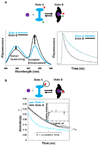Fluorescence anisotropy and resonance energy transfer: powerful tools for measuring real time protein dynamics in a physiological environment
- PMID: 20971683
- PMCID: PMC2981669
- DOI: 10.1016/j.coph.2010.09.013
Fluorescence anisotropy and resonance energy transfer: powerful tools for measuring real time protein dynamics in a physiological environment
Abstract
Fluorescence spectroscopy/microscopy is a versatile method for examining protein dynamics in vitro and in vivo that can be combined with other techniques to simultaneously examine complementary pharmacological parameters. The following review will highlight the advantages and challenges of using fluorescence spectroscopic methods for examining protein dynamics with a special emphasis on fluorescence resonance energy transfer and fluorescence anisotropy. Both of these methods are amenable to measurements on an ensemble of molecules as well as at the single molecule level, in live cells and in high throughput screening assays, providing a powerful set of tools to aid in the design and testing of new drugs under a variety of experimental conditions.
Copyright © 2010 Elsevier Ltd. All rights reserved.
Figures

Similar articles
-
Fluorescence anisotropy: from single molecules to live cells.Analyst. 2010 Mar;135(3):452-9. doi: 10.1039/b920242k. Epub 2010 Jan 7. Analyst. 2010. PMID: 20174695 Review.
-
High-Throughput Screening: today's biochemical and cell-based approaches.Drug Discov Today. 2020 Oct;25(10):1807-1821. doi: 10.1016/j.drudis.2020.07.024. Epub 2020 Aug 12. Drug Discov Today. 2020. PMID: 32801051 Review.
-
A dual-readout F2 assay that combines fluorescence resonance energy transfer and fluorescence polarization for monitoring bimolecular interactions.Assay Drug Dev Technol. 2011 Aug;9(4):382-93. doi: 10.1089/adt.2010.0292. Epub 2011 Mar 11. Assay Drug Dev Technol. 2011. PMID: 21395401 Free PMC article.
-
Ligand Discovery: High-Throughput Binding: Fluorescence Polarization (Anisotropy).Methods Mol Biol. 2021;2263:231-246. doi: 10.1007/978-1-0716-1197-5_10. Methods Mol Biol. 2021. PMID: 33877601
-
Fluorescence anisotropy (polarization): from drug screening to precision medicine.Expert Opin Drug Discov. 2015;10(11):1145-61. doi: 10.1517/17460441.2015.1075001. Epub 2015 Aug 3. Expert Opin Drug Discov. 2015. PMID: 26289575 Free PMC article. Review.
Cited by
-
Lipid-Bilayer Dynamics Probed by a Carbon Dot-Phospholipid Conjugate.Biophys J. 2016 May 10;110(9):2016-25. doi: 10.1016/j.bpj.2016.04.005. Biophys J. 2016. PMID: 27166809 Free PMC article.
-
Kinetics of Membrane Protein-Detergent Interactions Depend on Protein Electrostatics.J Phys Chem B. 2018 Oct 18;122(41):9471-9481. doi: 10.1021/acs.jpcb.8b07889. Epub 2018 Oct 5. J Phys Chem B. 2018. PMID: 30251852 Free PMC article.
-
A preformed binding interface in the unbound ensemble of an intrinsically disordered protein: evidence from molecular simulations.PLoS Comput Biol. 2012;8(7):e1002605. doi: 10.1371/journal.pcbi.1002605. Epub 2012 Jul 19. PLoS Comput Biol. 2012. PMID: 22829760 Free PMC article.
-
Measurement of drug-target engagement in live cells by two-photon fluorescence anisotropy imaging.Nat Protoc. 2017 Jul;12(7):1472-1497. doi: 10.1038/nprot.2017.043. Epub 2017 Jun 29. Nat Protoc. 2017. PMID: 28686582 Free PMC article.
-
Interaction of Selected Phenylpropenes with Dipalmitoylphosphatidylcholine Membrane and Their Relevance to Antibacterial Activity.J Membr Biol. 2017 Jun;250(3):259-271. doi: 10.1007/s00232-017-9957-y. Epub 2017 Apr 22. J Membr Biol. 2017. PMID: 28434115
References
-
- Royer CA, Scarlata SF. Fluorescence approaches to quantifying biomolecular interactions. Methods Enzymol. 2008;450:79–106. - PubMed
-
- Budisa N, Pal PP. Designing novel spectral classes of proteins with a tryptophanexpanded genetic code. Biol Chem. 2004;385:893–904. - PubMed
-
- Iijima I, Hohsaka T. Position-specific incorporation of fluorescent non-natural amino acids into maltose-binding protein for detection of ligand binding by FRET and fluorescence quenching. Chembiochem. 2009;10:999–1006. - PubMed
Publication types
MeSH terms
Substances
Grants and funding
LinkOut - more resources
Full Text Sources

